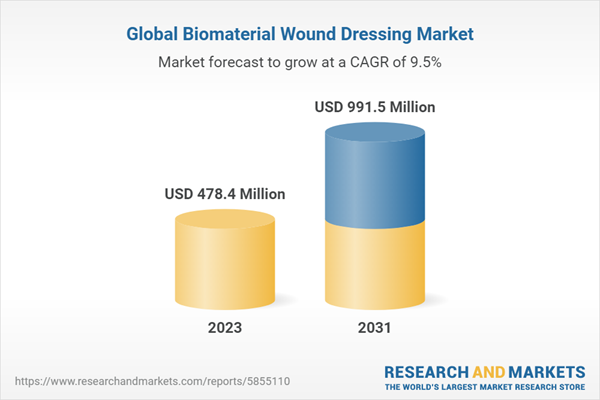Biomaterial Wound Dressing: Introduction
Biomaterial wound dressings are innovative products that are designed to facilitate the healing of wounds and promote tissue regeneration. These dressings are made from various biocompatible materials, such as natural polymers, synthetic polymers, and composite materials, which offer unique properties to enhance the wound healing process.The primary goal of biomaterial wound dressings is to create an optimal environment for wound healing. They provide a protective barrier against external contaminants, manage moisture levels, and facilitate the exchange of gases between the wound and the surrounding environment. Additionally, these dressings can offer antimicrobial properties, control inflammation, and promote the growth of new tissue.
Key Trends in the Global Biomaterial Wound Dressing Market
Key trends in the biomaterial wound dressing market include:
- Advanced Wound Healing: Biomaterial wound dressings are being developed with advanced features to accelerate the healing process. These include the incorporation of growth factors, bioactive molecules, and stem cells to promote tissue regeneration and angiogenesis
- Customization and Personalization: There is a growing trend towards customized and personalized wound dressings. Biomaterials can be tailored to specific wound types, sizes, and patient needs. Customization allows for better wound management and improved patient outcomes
- Biodegradability and Sustainability: There is increasing focus on developing biodegradable and environmentally friendly biomaterials for wound dressings. These materials reduce the need for dressing removal and minimize waste generation. Biodegradable dressings eliminate the requirement for additional interventions, such as dressing changes, which can lead to improved patient comfort and cost-effectiveness
- Smart Wound Dressings: The integration of smart technologies in biomaterial wound dressings is a rising trend. These dressings can monitor wound conditions, provide real-time feedback, and deliver targeted therapies based on wound progress. Smart wound dressings have the potential to enhance wound healing outcomes and optimize patient care
Global Biomaterial Wound Dressing Market Segmentations
Market Breakup by Product
- Alginate Dressing
- Hydrocolloids
- Skin Substitutes
- Others
Market Breakup by Type
- Primary
- Secondary
Market Breakup by Applications
- Wounds
- Burns
- Ulcers
- Others
Market Breakup by End User
- Hospitals and Clinics
- Ambulatory Surgical Centers
- Homecare
- Others
Market Breakup by Region
- North America
- Europe
- Asia Pacific
- Latin America
- Middle East and Africa
Global Biomaterial Wound Dressing Market Scenario
The market for biomaterial wound dressings is experiencing significant growth and is driven by the increasing prevalence of chronic wounds, the demand for advanced wound care solutions, and the development of innovative biomaterials. Biomaterial wound dressings offer several advantages over traditional wound dressings, such as enhanced wound healing, improved infection control, and customization based on the wound type and patient needs.These dressings are designed to create an optimal environment for wound healing by providing a protective barrier, managing moisture levels, and promoting tissue regeneration. They can be made from natural polymers, synthetic polymers, or composite materials, each offering unique properties to support the healing process. Additionally, biomaterial wound dressings may incorporate advanced features like growth factors, bioactive molecules, and smart technologies to further enhance healing outcomes.
Another trend is the focus on biodegradability and sustainability. With an increasing emphasis on environmental impact, there is a demand for biomaterial wound dressings that are biodegradable and eco-friendly. Biodegradable dressings eliminate the need for dressing removal, reducing patient discomfort and minimizing waste generation. This trend aligns with the broader sustainability goals of healthcare systems worldwide.
The market for biomaterial wound dressings is competitive and dynamic, with several key players offering a wide range of products. These companies invest in research and development to develop new biomaterials and technologies, aiming to provide innovative solutions for wound care. As the demand for advanced wound care continues to rise, the market is expected to expand, driven by the development of novel biomaterials, increasing adoption of personalized treatment approaches, and technological advancements in wound healing.
Global Biomaterial Wound Dressing Market: Competitor Landscape
The key features of the market report include patent analysis, grants analysis, clinical trials analysis, funding and investment analysis, partnerships, and collaborations analysis by the leading key players. The major companies in the market are as follows:- Smith & Nephew plc
- Molnlycke Health Care AB
- Integra LifeSciences Holdings Corporation
- Convatec Group plc
- 3M Company
- Medtronic plc
- Johnson & Johnson
- Hollister Incorporated
- B. Braun Melsungen AG
- DermaRite Industries LLC
Table of Contents
Companies Mentioned
- Smith & Nephew plc.
- Molnlycke Health Care AB
- Integra LifeSciences Holdings Corporation
- Convatec Group plc
- 3M Company
- Medtronic plc
- Johnson & Johnson
- Hollister Incorporated
- B. Braun Melsungen AG
- DermaRite Industries LLC
Table Information
| Report Attribute | Details |
|---|---|
| No. of Pages | 160 |
| Published | June 2023 |
| Forecast Period | 2023 - 2031 |
| Estimated Market Value ( USD | $ 478.4 Million |
| Forecasted Market Value ( USD | $ 991.5 Million |
| Compound Annual Growth Rate | 9.5% |
| Regions Covered | Global |
| No. of Companies Mentioned | 10 |









